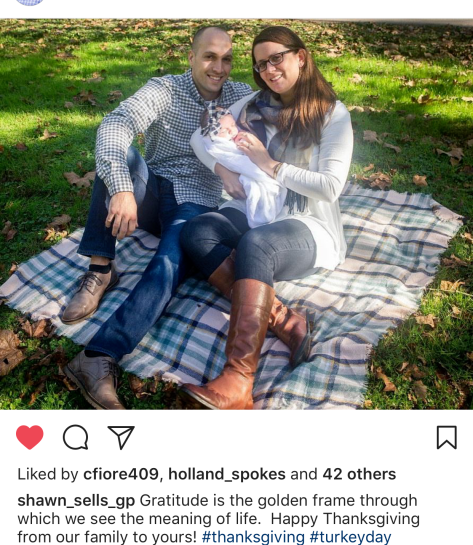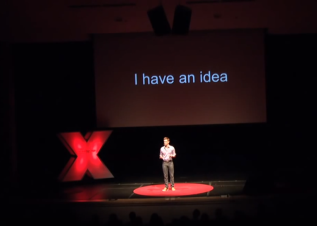Tools of the Trade: Gratitude
Gratitude is the golden frame through which we see the meaning of life. -Brendon Burchard
 This past Thanksgiving my husband posted these words to his Instagram account along with this picture of our happy family. As you can see from the photo, I have a lot to be grateful for in my personal life this year. However, at the time I read this post I had just returned to school and was feeling the strain of balancing my work and home life along with missing my daughter and trying to play catch up with my classes. Needless to say I was forgetting to look through this golden frame in my professional life.
This past Thanksgiving my husband posted these words to his Instagram account along with this picture of our happy family. As you can see from the photo, I have a lot to be grateful for in my personal life this year. However, at the time I read this post I had just returned to school and was feeling the strain of balancing my work and home life along with missing my daughter and trying to play catch up with my classes. Needless to say I was forgetting to look through this golden frame in my professional life.
My husband’s post reminded me of a project I undertook with my students last school year and inspired me to attempt it again this year. Around Thanksgiving time I showed them a TEDx titled “Unlimited Gratitude” by Brian Doyle. In this talk, a young man describes a near death experience that awakened him to the realization that he needed to express his gratitude to the people in his life; not just once a year, but everyday. So he  created a year-long project in which he set out to personally thank a different person every single day. At the end of his talk he issues a call to action to his audience: “I want to call on us to think about these people in our lives that we appreciate. Those that we have gratitude for. Those that we’re thankful for… And let’s not stop there. Let’s say it. Let’s tell them before it’s too late.”
created a year-long project in which he set out to personally thank a different person every single day. At the end of his talk he issues a call to action to his audience: “I want to call on us to think about these people in our lives that we appreciate. Those that we have gratitude for. Those that we’re thankful for… And let’s not stop there. Let’s say it. Let’s tell them before it’s too late.”

A student’s first entry from this year’s project.
I used these words to issue a gratitude challenge to my students. After watching Brian’s talk, I had students freewrite about the people and things they are grateful for and then gave them time to create handmade thank you notes to one or two of the people on their lists. Throughout the remainder of the school year we returned to this idea by adding weekly entries to a gratitude section of our writer’s notebooks. I simply gave my students a few quiet minutes once a week to add to their gratitude lists or to freewrite about what was going well in their lives. I also kept a bin of blank thank you cards in the front of my room and during down time or when individual students finished assignments early, I prompted them to write another thank you note for someone on their gratitude lists. By the end of the school year, students who started this project with only one or two things on their lists or who adamantly insisted they had nothing to be grateful for ended up with pages of listed gratitudes.
I also responded to Brian’s call to action by taking on my own gratitude project. I challenged myself to write a thank you card to a different student every day of the school year. Consequently, I adopted a new, more positive morning routine. When I first sat down at my desk, rather than look over what I hadn’t quite accomplished the day before or start to plan the upcoming day, I instead reviewed my roster of students and thought about who I was particularly grateful for that day. This challenge forced me to personally connect with every single one of my 87 students. It also prompted me to think positively and praise some of my more challenging students. For example, the week Pedro threw his binder across the room and stormed out in a fit of curse words, I chose to write his thank you card so that I could think of him in a positive light as well as let him know how and why I valued him as a student in my classroom despite his behavior. While I may have missed writing my thank you on a morning here and there, by the end of the school year I managed to personally thank every one of my students for their unique and valuable contributions to the class. I was able to communicate how much I appreciated their writing, the risks they took in sharing during a discussion, the extra help they offered to clean up the room or set up a bulletin board, the creativity they added to their projects, the support they offered each other, etc. And as an unplanned benefit, it also encouraged them to continue these behaviors. Overall, it was a really uplifting way to spend a few minutes each morning and I’m looking forward to bringing this positivity back into my daily routine.
What are you grateful for in your professional life? How do you find space for gratitude in the daily grind of teaching? How do you encourage your students to notice and express their appreciations?
 Kelly Virgin teaches English for the Kennett Consolidated School District and has been a PAWLP fellow since 2010. She is a proud bookworm and loves sharing her passion for reading and writing with her students. Through PAWLP, she facilitates the Strategies for Teaching Literature course in the spring and the Grammar Matters course in the summer.
Kelly Virgin teaches English for the Kennett Consolidated School District and has been a PAWLP fellow since 2010. She is a proud bookworm and loves sharing her passion for reading and writing with her students. Through PAWLP, she facilitates the Strategies for Teaching Literature course in the spring and the Grammar Matters course in the summer.




Kelly,
What a wonderful assignment — something we can all try in our daily lives.
Thank you for sharing!
Mary
LikeLike
Kelly, I really felt inspired by this post. I agree we should encourage the awareness and expression of gratitude in our classrooms. I have worked with teachers of all levels who have guided their students to write/draw about why they appreciate various classmates. At the end of our grad class semester, we write notes of appreciation to each other. It means a lot.
LikeLike
That sounds like a great TED talk and a great assignment for your students! Thank you for sharing this post. Wish you the best – speak766
LikeLike